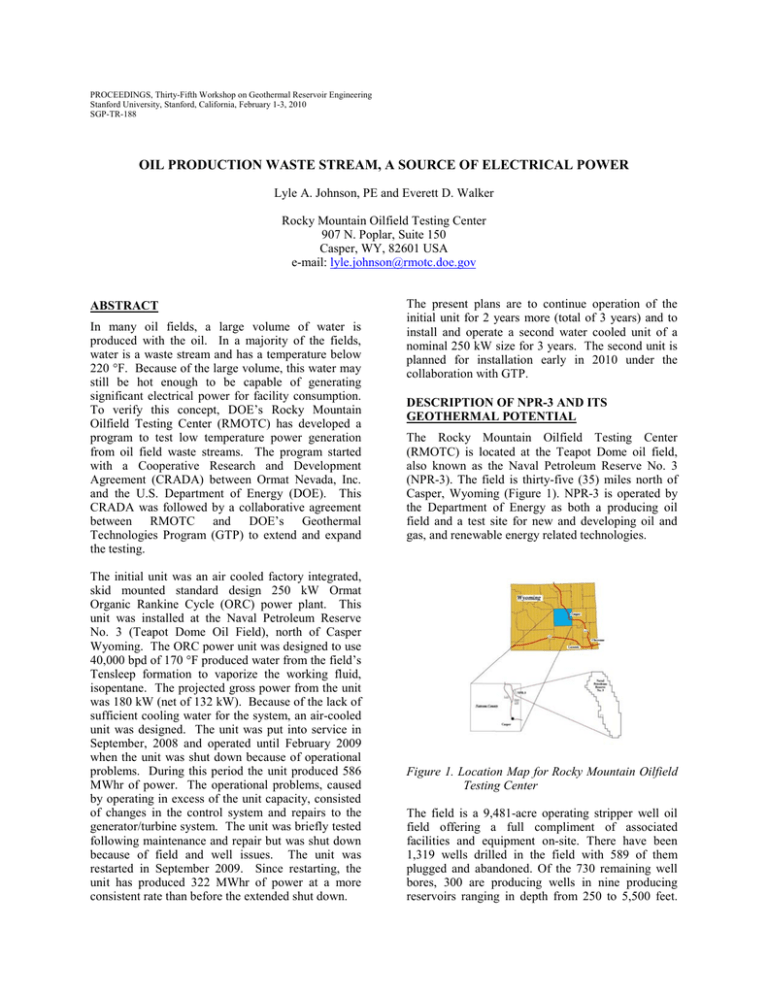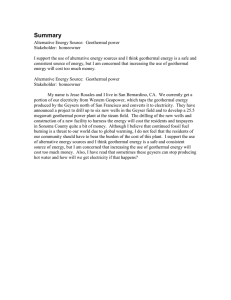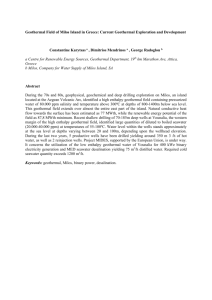PROCEEDINGS, Thirty-Fifth Workshop on Geothermal Reservoir Engineering
advertisement

PROCEEDINGS, Thirty-Fifth Workshop on Geothermal Reservoir Engineering Stanford University, Stanford, California, February 1-3, 2010 SGP-TR-188 OIL PRODUCTION WASTE STREAM, A SOURCE OF ELECTRICAL POWER Lyle A. Johnson, PE and Everett D. Walker Rocky Mountain Oilfield Testing Center 907 N. Poplar, Suite 150 Casper, WY, 82601 USA e-mail: lyle.johnson@rmotc.doe.gov ABSTRACT In many oil fields, a large volume of water is produced with the oil. In a majority of the fields, water is a waste stream and has a temperature below 220 °F. Because of the large volume, this water may still be hot enough to be capable of generating significant electrical power for facility consumption. To verify this concept, DOE’s Rocky Mountain Oilfield Testing Center (RMOTC) has developed a program to test low temperature power generation from oil field waste streams. The program started with a Cooperative Research and Development Agreement (CRADA) between Ormat Nevada, Inc. and the U.S. Department of Energy (DOE). This CRADA was followed by a collaborative agreement between RMOTC and DOE’s Geothermal Technologies Program (GTP) to extend and expand the testing. The initial unit was an air cooled factory integrated, skid mounted standard design 250 kW Ormat Organic Rankine Cycle (ORC) power plant. This unit was installed at the Naval Petroleum Reserve No. 3 (Teapot Dome Oil Field), north of Casper Wyoming. The ORC power unit was designed to use 40,000 bpd of 170 °F produced water from the field’s Tensleep formation to vaporize the working fluid, isopentane. The projected gross power from the unit was 180 kW (net of 132 kW). Because of the lack of sufficient cooling water for the system, an air-cooled unit was designed. The unit was put into service in September, 2008 and operated until February 2009 when the unit was shut down because of operational problems. During this period the unit produced 586 MWhr of power. The operational problems, caused by operating in excess of the unit capacity, consisted of changes in the control system and repairs to the generator/turbine system. The unit was briefly tested following maintenance and repair but was shut down because of field and well issues. The unit was restarted in September 2009. Since restarting, the unit has produced 322 MWhr of power at a more consistent rate than before the extended shut down. The present plans are to continue operation of the initial unit for 2 years more (total of 3 years) and to install and operate a second water cooled unit of a nominal 250 kW size for 3 years. The second unit is planned for installation early in 2010 under the collaboration with GTP. DESCRIPTION OF NPR-3 AND ITS GEOTHERMAL POTENTIAL The Rocky Mountain Oilfield Testing Center (RMOTC) is located at the Teapot Dome oil field, also known as the Naval Petroleum Reserve No. 3 (NPR-3). The field is thirty-five (35) miles north of Casper, Wyoming (Figure 1). NPR-3 is operated by the Department of Energy as both a producing oil field and a test site for new and developing oil and gas, and renewable energy related technologies. Figure 1. Location Map for Rocky Mountain Oilfield Testing Center The field is a 9,481-acre operating stripper well oil field offering a full compliment of associated facilities and equipment on-site. There have been 1,319 wells drilled in the field with 589 of them plugged and abandoned. Of the 730 remaining well bores, 300 are producing wells in nine producing reservoirs ranging in depth from 250 to 5,500 feet. The remaining wellbores are temporarily shut-in or are used for testing. Two formations at NPR-3, the Tensleep and Madison formations, produce sufficient hot water for the generation of low-temperature geothermal energy. The current flowing water resource from these formations is 45,000 barrels of water per day (BWPD). The present and potential areas for Tensleep and Madison production are shown in Figure 2. The average production temperature for the Tensleep is 195-200 °F and for the Madison is 200210 °F. It is projected that with minor work on existing wells, the rate for the combined Tensleep and Madison produced water would be between 126 and 210 MBWPD. The water resource in both the Tensleep and Madison formations are continuously recharged from mountains to the west. Currently the hot water in the oil field is a waste stream and is treated through a series of treatment ponds and then discharged into an adjacent stream. tube condensers (Figure 3). The unit was wired directly into a 480 volt leg of the field power distribution system. The power from the unit is metered and monitored for reliability and quality. For field safety purposes, the Ormat unit was installed such that the unit shuts down if the main field power is interrupted. The proposed second power generation unit will have the same nominal output but will be water cooled. These similar but different generation units will provide operational data from the perspective of the oil field. 17-WX-21 Madison and Tensleep Possibly 35 MBWPD flowing 57-WX-3 Madison and Tensleep Possibly 10 MBWPD flowing Figure 3. 250 kW ORC Low-Temperature Geothermal System at NPR-3 TENSLEEP PRODUCING AREA Precambrian granitic basement structure OTHER POSSIBLE TENSLEEP SOURCE WELLS AND DEEPENING CANDIDATES Figure 2. Potential Geothermal Supply Wells at NPR-3 POWER GENERATION UNITS The initial unit was designed, constructed and supplied by Ormat Nevada Inc., under a Cooperative Research and Development Agreement (CRADA). Design was based on Ormat’s experience and operation of geothermal power plants in Nevada, California, Hawaii and Austria. The purpose of the initial testing was to validate the premise that a binary geothermal power generation system that uses the hot water produced during normal oil field operations can reliably generate commercial electricity. This first unit has a nominal rating of 250 kW and has three main components: an 8 ft by 40 ft vaporizer skid which also contains the turbine, generator, and instrumentation cabinet; and two 8 ft by 40 ft finned- RESULTS AND DISCUSSION The air-cooled power generation system was installed in August 2008. The design of the unit was based on a relatively low produced water temperature of 170 °F and an average ambient temperature of 50 °F, Table 1. At design conditions, the nominal 250 kW unit would produce a gross power of 180 kW (net 132 kW). However, between initial design and installation, two major changes were made. With the equipment, the pump for the working fluid, isopentane, was incorporated into the turbinegenerator package. By incorporating this feature, the parasitic electrical load of the unit was decreased from 48 to 25 kW. On the field side, the Tensleep production facility was upgraded and an insulated, produced water storage tank installed. This upgrade kept the produced water temperature in the 195 to 198 °F range. The higher inlet water temperature permitted the system to operate nearer the optimum/maximum net power output of 225 kW. The operational results are divided into two phases. The first phase is from September 2008 to February 2009, the period from initial startup of the unit until shut down for repair and maintenance. The second phase is from on Figure 5 for phase 1. During phase 1, the unit produced over 586 megawatt hours of power from 3.0 million barrels of hot water. The online percentage for the unit during this period was 91% considering both field and unit related down time. The down time attributed to unit issues was only 3%. Therefore, the unit had a 97% online percentage. The system related downtimes were largely the results of the operator’s learning curve until the shutdown in February 2009. September 2009 to January 2010. The period between the two phases was when the unit was down for repairs and maintenance and for correction of field issues. These corrections are discussed later. For phase 1, the net power output averaged 171 kW with a range of 80 to 280 kW, Table 1. The output power fluctuated with the average daily ambient temperature when a constant hot water inlet volume was used, Figure 4. The power fluctuation is evident through the normal daily temperature cycle, red line Figure 4: Daily Power Output and Ambient Temperature Table 1. Design and Operational Data Design Operational Results Phase 1 Flow rate, bpd 40,000 Total hot water used, bbl Phase 2 12,000 to 40,000 11,500 to 35,000 3,047,192 1,723,665 Inlet water temperature, °F 170 195 to 198 196 to 198 Outlet water temperature, °F 152 80 to 170 47 to 150 Average ambient temp., °F 50 -7 to 85 0 to 58 Generator gross power, kW 180 105 to 305 160 to275 Daily avg. net power output, kW 132 80 to 280 135 to 250 Overall avg. net power, kW 171 187 Average net power, last 30 days of each phase, kW 207 216 586,574 322,414 Total power produced, kWhr Figure 5: Daily Power Fluctuation In February 2009, the unit was shut down because of equipment problems. These repairs were required because the unit was operated above the net rating of the generator of 225 kW for a 2 week period, Figure 4. It was determined that changes in the control system and repairs to the generator/turbine system were needed. The higher than acceptable power generation damaged the front bearing and eventually the outboard bearing on the generator. The unit was removed, repaired and reinstalled with a new control system. The repairs consisted of replacement of the generator bearings and replacement of the mechanical seal between the turbine and generator. The new control system included the installation of a second hot-water flow control valve, a turbine vibration sensor and temperature probes on both generator bearings. The startup control for the unit was also changed providing for a smoother, startup. The unit was restarted in May 2009 but was shut down to address related field issues with the production wells and electrical system. To date, phase 2 has averaged 189 kW net power output with a range of 135 to 250 kW, Table 1. The output power fluctuates with the average daily ambient temperature when a constant hot water inlet volume is used, Figure 4. The daily power fluctuation has been decreased, compare green line for phase 2 with red line for phase 1 in Figure 5. During phase 2, the unit has produced over 322 megawatt hours of power from 1.7 million barrels of hot water. The online percentage for the unit, eliminating downtime caused by field activities, has been a 97%. The power output of the unit over the last 30 days has averaged 216 kW with a control set point of 220 kw. RMOTC’s present plans are to continue to operate the unit for an addition 2 years under a collaborative agreement with DOE’s Geothermal Technologies Program. Also under this program, a second power generation unit of the same nominal generation capacity but water cooled will be installed and tested for 3 years. This will provide operational data and experience to transfer to potential users for both air and water cooled systems in both an oil field and low temperature geothermal settings. During this time, RMOTC will be developing a test facility for smaller geothermal systems and developing plans for EGS applications and testing.






![[date] Mr. Theodore Schade Mr. Steven L. Nelson Air Pollution](http://s3.studylib.net/store/data/007013598_1-3d330ddff330ed2bd0a1f2fb95eff24b-300x300.png)

